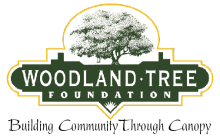Over twenty years ago Woodland Tree Foundation began fall and winter tree planting on a mostly barren five-mile segment of the State Route 113 ribbon of highway linking Woodland and Davis. During the hot and dusty summer months volunteers hand water seedlings for an average of two years until establishment. After that, the trees are on their own. Many, but not all, trees survive.

In 2020 the Foundation counted over 1,000 trees in this 113 zone it had planted that were established, with some of the valley oaks reaching 20 feet tall. In 2023 that figure exceeded 1,100. According to Ken Trott, “We have a survival rate of around 65%. We lose seedlings because of ground squirrels, Caltrans mowing, sub-optimal watering, dry winters, and poor soil, among other things.” Several Foundation board members, past and present, have planted seedlings and watered them over the decades.
“We plant roadside where the soil is good quality and also on each on- and off-ramp between Main Street and Willow Slough (north of Road 29) where the soil was imported and compacted, which slows the growth rate of trees we plant,” according to Trott who along with David Wilkinson has planted and watered since the project began. “At the Road 29 quadrants, where we also plant, the soil is very salty (alkaline) which severely restricts which species can survive. Oaks cannot tolerate this soil, so we’ve learned the hard way (and from the advice of the Yolo Resource Conservation District), to plant salt-tolerant species of shrubs and grasses like atriplex “quail bush” and sacaton “salt grass.”
The Foundation has planted over 20 species of trees and shrubs, mostly natives. Valley oaks (63%) are the most prevalent species and are grown and planted as seedlings by the Foundation. “Historically, before farming and development, this area was a valley oak savanna with thicker stands in Woodland and near Willow Slough,” according to Wilkinson. This tree is right at home in its native habitat and very adaptable to hot, dry summers.” Another popular species is Chinese pistache (24%) which the Foundation plants for its radiant fall color and because it is a very tough tree.
“This winter the Foundation is focusing its planting in Woodland at the Gibson Road and Main Street on and off-ramps where there’s acres of land. The Gibson Road southbound exit has a long strip of land we call “the meadow,” said Rolf Frankenbach who has been working with Trott and Wilkinson for many years on 113.
Frankenbach added, “We planted valley oaks in this area years ago and now we are adding other native species such as interior live oak, buckeye, and chilopsis (desert willow). This year we are also planting foothill pine and toyon, California natives that are tough and adaptable to dry areas and attractive. We plant for both the environmental benefits and to make Woodland more attractive to motorists. We’ve also added more trees along Gum Avenue near the 113 overpass.”
Look for the translucent tree protectors and orange flags in these areas and then enjoy watching these trees grow each season. “It’s fun to see birds, bees, and other wildlife enjoying these trees and shrubs on the periphery of our busy urban areas,” said Trott.
The highway contains patches of native wildflowers, native creeping wild rye, and nonnative grasses which Caltrans mows each spring. “We are discussing the idea of creating a “corridor of wildflowers” in the center median linking Woodland-Davis, in consultation with the UC Davis Arboretum. The idea has received a favorable response from Yolo County Supervisors with districts touching 113. Hopefully, Caltrans will support the project,” said Wilkinson.
